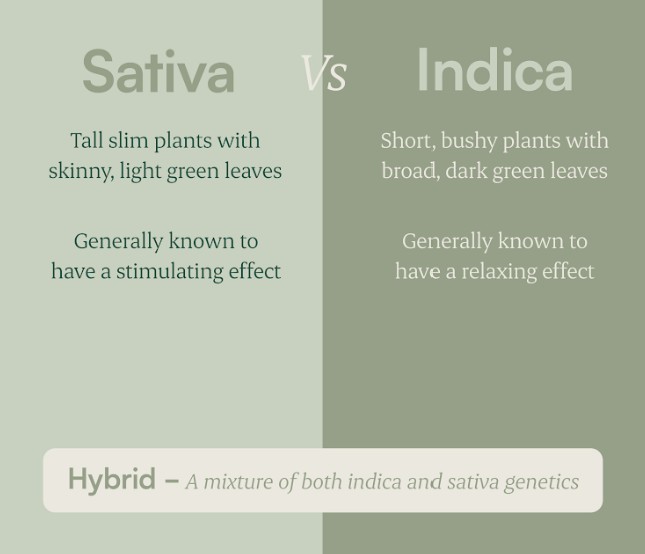Cannabis, a plant with a rich history and diverse applications, is often categorized into three main types: indica, sativa, and hybrid. While these classifications have been used for years to predict the effects of different cannabis varieties, understanding which one is “stronger” requires a closer look at their characteristics, chemical composition, and the evolving understanding of cannabis science.
A Brief History of Indica and Sativa
Cannabis is believed to have originated in Central Asia, spreading across the globe and adapting to various climates. These adaptations, combined with selective breeding, led to the development of landrace strains, each named after its region of origin. These landrace strains were eventually brought to the Western world and crossbred, resulting in the thousands of named cannabis varieties available today.
The terms “indica” and “sativa” originated from early classifications of the plant. In 1753, Carl Linnaeus classified all cannabis plants under the single species Cannabis sativa L. Later, in 1785, Jean-Baptiste Lamarck distinguished Cannabis indica as a separate species, based on physical differences and observed effects. Cannabis sativa was described as taller and more fibrous, while Cannabis indica was shorter, wider, and possessing greater psychoactive properties.
Today, these definitions have evolved, leading to the three main categories:
- Indica: Traditionally associated with relaxing and sedating effects.
- Sativa: Traditionally associated with uplifting and stimulating effects.
- Hybrid: A cross between indica and sativa strains, offering a combination of effects.
Indica: The Relaxing Strain?
Indica strains are often associated with relaxation and sedation.
Indica Origins
Cannabis indica is native to regions like Afghanistan, India, Pakistan, and Turkey.
Physical Characteristics
 Cannabis indica plant with broad, dark green leaves
Cannabis indica plant with broad, dark green leaves
Alt text: Close-up of a Cannabis indica plant showcasing its short, bushy structure and broad, dark green leaves.
Indica plants are typically shorter and stockier than sativa plants, with bushy foliage and broad, dark green leaves. They also tend to grow faster and produce more flowers.
Cannabinoid Profile
While traditionally thought to have higher CBD levels, the THC content in indica strains can vary significantly.
Commonly Associated Effects
Based on anecdotal reports, indica strains are often linked to relaxation, sedation, and potential relief from stress and sleep issues.
Sativa: The Energizing Strain?
Sativa strains are generally known for their uplifting and stimulating effects.
Sativa Origins
Sativa strains are native to warmer climates, such as Eastern Asia and Central and South America.
Plant Properties
Sativa plants are taller and slimmer than indicas, with thin, light green leaves. They also typically take longer to mature.
Cannabinoid Balance
Sativa strains tend to have a lower ratio of CBD to THC compared to indicas, but this is not always the case.
Commonly Associated Effects
Cannabis sativa is often associated with stimulating effects, potentially increasing creativity, focus, and reducing stress-related symptoms.
Hybrid Cannabis: The Best of Both Worlds?
Hybrid cannabis strains are created by crossbreeding indica and sativa plants.
Hybrid Development
Cannabis cultivators constantly create new and unique hybrid strains, often targeting specific effects. Hybrids can be indica-dominant, sativa-dominant, or balanced, depending on their genetic lineage.
The Effects of Hybrids
The effects of a hybrid strain depend on its genetic makeup and, more importantly, its cannabinoid and terpene content. Hybrids are often cultivated to elicit specific effects, such as stress relief, pain relief, and more.
The Shifting Paradigm: Beyond Indica and Sativa
Modern research suggests that years of crossbreeding have blurred the lines between sativa and indica strains. Pure indica or pure sativa strains are now rare.
Focus on Chemotypes
Many industry professionals now classify cannabis based on its chemotype, defined by the levels of major cannabinoids CBD and THC:
- Type I: High THC: More than 0.3% THC and less than 0.5% CBD.
- Type II: THC/CBD: High contents of both CBD and THC.
- Type III: High CBD: Less than 0.3% THC.
The Importance of Terpenes and Minor Cannabinoids
Terpenes, minor cannabinoids (like CBG and CBN), flavonoids, and other compounds play a significant role in the therapeutic potential of cannabis strains.
Whole Plant Approach
A whole-plant approach, considering the full spectrum of cannabinoids and terpenes, may be the most effective way to harness the healing potential of cannabis.
Cannabis Ruderalis: The Third Strain
Cannabis ruderalis is a third type of cannabis strain, containing low quantities of cannabinoids.
Ruderalis Origins
Ruderalis plants are found in extreme environments, such as Eastern Europe, the Himalayas, Siberia, and Russia.
Plant Properties
Ruderalis plants are small and bushy, rarely exceeding 30 centimeters in height, and grow rapidly.
Cannabinoid Balance
Ruderalis typically contains very little THC and somewhat higher amounts of CBD, but not enough to produce noticeable effects.
Associated Effects
Ruderalis is not typically used for medicinal or recreational purposes on its own, but it may be bred with other cannabis types.
What Is Stronger, Indica or Sativa? Understanding Psychoactive Effects
In terms of intoxicating or psychoactive effects, sativa strains are generally said to be “stronger” than indica strains because of their higher THC content. THC is a psychoactive cannabinoid that produces the “high” commonly associated with cannabis use.
It is important to remember that THC can be impairing and may cause adverse side effects at higher doses in some individuals.
Mixing Indica and Sativa Strains
Mixing different strains of cannabis can alter the overall effects, similar to creating a hybrid strain. If a doctor prescribes two different strains, they likely have specific reasons for doing so. Always consult with a healthcare professional about the best time to take each strain and whether they can be safely taken together.
Experimenting with or consuming too much of any cannabis strain can lead to negative effects. It is always best to follow the advice of a doctor.
Finding the Right Strain for You
The best way to find the cannabis strain that works for you is to consult with a licensed healthcare professional. A doctor experienced in medicinal cannabis can help determine the best treatment plan based on your individual needs, available strains, cannabinoid and terpene content, and preferred delivery methods.
Conclusion: The Nuances of Cannabis Potency
While the terms indica and sativa are still used, understanding the overall potency of cannabis now relies on analyzing the chemotype as well as minor cannabinoids and terpenes. For a better understanding, it is always recommended to seek expert medical advice. The information provided in this article should not be considered medical advice and should be used for educational purposes only.
